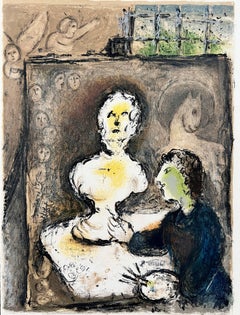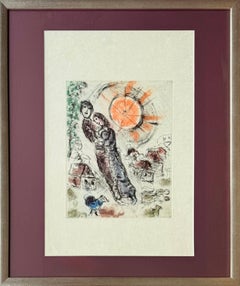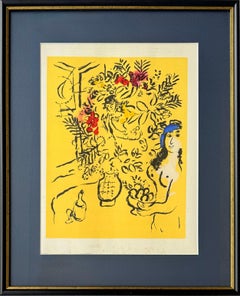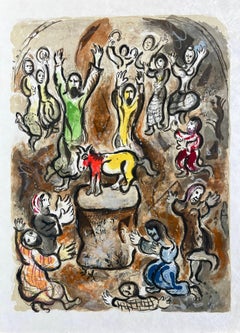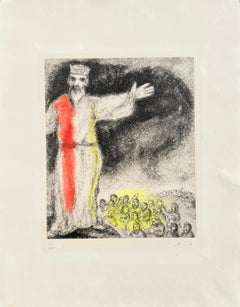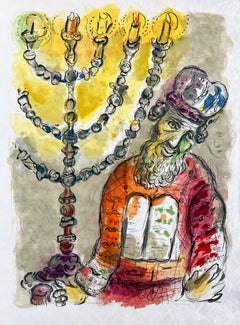More Prints
to
8
55
91
19
2
2
Overall Width
to
Overall Height
to
52
19
3
1
131
295
646
450
206
131
38
10
5
19
71
22
3
114
38
17
16
14
13
9
4
3
2
2
1
94
36
35
35
26
19
53
136
33
More Prints For Sale
Artist: Marc Chagall
Artist: Enzio Wenk
Marc Chagall - L'Odyssée, Planche I
By Marc Chagall
Located in OPOLE, PL
Marc Chagall (1887-1985) - Marc Chagall - L'Odyssée, Planche I
Lithograph from 1974.
An unnumbered and unsigned copy from a limited edition of 270.
Dimensions of work: 42.5 x 32 c...
Category
1970s Surrealist More Prints
Materials
Lithograph
Soleil aux amoureux
By Marc Chagall
Located in OPOLE, PL
Marc Chagall (1887-1985) - Soleil aux amoureux
Etching from 1968.
Trial proof - unique work.
Dimensions of sheet: 51 x 34 cm
Dimensions in frame: 63.2 x 53.2 cm
Publisher: Maegh...
Category
1960s Surrealist More Prints
Materials
Etching
Cover for Menu (trial proof)
By Marc Chagall
Located in OPOLE, PL
Marc Chagall (1887-1985) - Cover for Menu (trial proof)
Lithograph from 1964.
Trial proof - unique work.
Dimensions of sheet: 45 x 32 cm
Dimensions in frame: 53.2 x 43.2 cm
Publ...
Category
1960s Surrealist More Prints
Materials
Lithograph
Then all the people pluckt from themselves the golden eare-rings... - The Exodus
By Marc Chagall
Located in OPOLE, PL
Marc Chagall (1887-1985) - Then all the people pluckt from themselves the golden eare-rings, and they brought them unto Aaron who received them...
Lithograph from 1966.
The edition...
Category
1960s Symbolist More Prints
Materials
Lithograph
Joshua Stops the Sun
By Marc Chagall
Located in OPOLE, PL
Marc Chagall (1887-1985) - Joshua Stops the Sun
Etching from 1952 from “Bible”. 3.
Edition information: (61/100)
Enhanced with watercolour by the artist.
Dimensions of work: 52 x...
Category
1950s Symbolist More Prints
Materials
Watercolor, Etching
Thou shalt also anoint Aaron and his sonnes, and shalt... - The Exodus
By Marc Chagall
Located in OPOLE, PL
Marc Chagall (1887-1985) - Thou shalt also anoint Aaron and his sonnes, and shalt consecrate them, that they may minister unto me in the Priests offices
Lithograph from 1966.
The e...
Category
1960s Symbolist More Prints
Materials
Lithograph
Le Sept Péchés Capitaux
By Marc Chagall
Located in OPOLE, PL
Marc Chagall (1887-1985) - Le Sept Péchés Capitaux
Etching from 1925.
Edition of 300 proofs.
Dimensions of work: 25 x 19.5 cm.
Publisher: Tériade, Paris.
Reference: Kornfeld 47....
Category
1920s Symbolist More Prints
Materials
Etching
Le Sept Péchés Capitaux
By Marc Chagall
Located in OPOLE, PL
Marc Chagall (1887-1985) - Le Sept Péchés Capitaux
Etching from 1925.
Edition of 300 proofs.
Dimensions of work: 25 x 19.5 cm.
Publisher: Tériade, Paris.
Reference: Kornfeld 47....
Category
1920s Symbolist More Prints
Materials
Etching
Profile and Red Child, from Mourlot Lithographe I
By Marc Chagall
Located in Washington, DC
Artist: Marc Chagall
Title: Profile and Red Child
Portfolio: Mourlot Lithographe I
Medium: Lithograph
Year: 1960
Edition: Unnumbered
Framed Size: 18 1/2" x 15 1/2"
Image Size: 12 1/2...
Category
1960s Modern More Prints
Materials
Lithograph
Zao Wou-ki - Sans titre
By Marc Chagall
Located in OPOLE, PL
Zao Wou-Ki (1921-2013) - Sans titre
Lithograph from 1967.
Edition 420/700.
Dimensions of work: 31 x 23 cm
Publisher: Galerie de France, Paris.
Printed by: E. and J. Dejobert, Pa...
Category
1960s Symbolist More Prints
Materials
Lithograph
Then Moses assembled all the Congregation of the children of Israel - The Exodus
By Marc Chagall
Located in OPOLE, PL
Marc Chagall (1887-1985) - Then Moses assembled all the Congregation of the children of Israel, and sayde unto them...
Lithograph from 1966.
The edition of 20 on Japanese paper.
D...
Category
1960s Symbolist More Prints
Materials
Lithograph
Self-Portrait (Frontispiece), from 1960 Mourlot Lithographe I
By Marc Chagall
Located in Washington, DC
Artist: Marc Chagall
Title: Self-Portrait (Frontispiece)
Portfolio: Mourlot Lithographe I
Medium: Lithograph
Date: 1960
Edition: Unnumbered
Frame Size: 21 7/8" x 18 7/8"
Sheet Size: ...
Category
1960s More Prints
Materials
Lithograph
La Fortune et le Jeune Enfant
By Marc Chagall
Located in OPOLE, PL
Marc Chagall (1887-1985) - La Fortune et le Jeune Enfant
Etching from 1954.
Edition of 100.
Enhanced with watercolour by the artist.
Dimensions of work: 39 x 30 cm.
Reference: C...
Category
1950s Symbolist More Prints
Materials
Lithograph
Et Sur la Terre...
By Marc Chagall
Located in OPOLE, PL
MARC CHAGALL (1887–1985)
André Malraux, Et Sur la Terre...
A complete artist's book from 1977, printed on BFK Rives wove paper. It includes 15 etchings with aquatint, along with the...
Category
1970s Symbolist More Prints
Materials
Lithograph
Moïse fait jaillir leau du rocher
By Marc Chagall
Located in OPOLE, PL
Marc Chagall (1887-1985) - Moïse fait jaillir leau du rocher
Etching from 1952.
From “Bible”. 2. Edition 15 of 100.
Enhanced with watercolour by the artist.
Dimensions of work: 5...
Category
1950s Symbolist More Prints
Materials
Lithograph
L'Arbre Vert aux Amoureux
By Marc Chagall
Located in OPOLE, PL
Marc Chagall (1887-1985) - L'Arbre Vert aux Amoureux
Lithograph from 1980.
Unsigned and unnumbered apart from the edition of 50.
Dimensions of work: 64.5 x 48 cm.
Reference: Chag...
Category
1930s Symbolist More Prints
Materials
Lithograph
Moses wrath waxed hote, and he cast the Tables out of his... - The Exodus
By Marc Chagall
Located in OPOLE, PL
Marc Chagall (1887-1985) - Moses wrath waxed hote, and he cast the Tables out of his handes, and brake them in pieces beneath the mountaine
Lithograph from 1966.
The edition of 20...
Category
1960s Symbolist More Prints
Materials
Lithograph
Couple sur fond noir II.
By Marc Chagall
Located in OPOLE, PL
Marc Chagall (1887-1985) - Couple sur fond noir
Lithograph from 1974.
This impression is notated as “Epreuve d’exposition H.C”. apart from the edition of 50 on Japon paper.
Unsign...
Category
1970s Symbolist More Prints
Materials
Lithograph
L'Opéra de Paris
By Marc Chagall
Located in OPOLE, PL
Marc Chagall (1887-1985) - L'Opéra de Paris
Lithograph from 1954.
Dimensions of sheet: 38 x 28 cm
Dimensions in frame: 53.2 x 43.2 cm
Publisher: Maeght Éditeur, Paris.
Printer: ...
Category
1950s Surrealist More Prints
Materials
Lithograph
Le Carrousel du Louvre
By Marc Chagall
Located in OPOLE, PL
Marc Chagall (1887-1985) - Le Carrousel du Louvre
Lithograph from 1954.
Dimensions of sheet: 38 x 28 cm
Dimensions in frame: 53.2 x 43.2 cm
Publisher: Maeght Éditeur, Paris.
Pri...
Category
1950s Surrealist More Prints
Materials
Lithograph
Celui qui dit les choses sans rien dire, Planche XII
By Marc Chagall
Located in OPOLE, PL
Marc Chagall (1887-1985) - Celui qui dit les choses sans rien dire, Planche XII
Etching and aquatint from 1976.
An unnumbered and unsigned copy in black, outside from signed editio...
Category
1970s Surrealist More Prints
Materials
Etching, Aquatint
Celui qui dit les choses sans rien dire, Planche V
By Marc Chagall
Located in OPOLE, PL
Marc Chagall (1887-1985) - Celui qui dit les choses sans rien dire, Planche V
Etching and aquatint from 1976.
An unnumbered and unsigned copy in black, outside from signed edition ...
Category
1970s Surrealist More Prints
Materials
Etching, Aquatint
Celui qui dit les choses sans rien dire, Planche XVI
By Marc Chagall
Located in OPOLE, PL
Marc Chagall (1887-1985) - Celui qui dit les choses sans rien dire, Planche XVI
Etching and aquatint from 1976.
An unnumbered and unsigned copy in black, outside from signed editio...
Category
1970s Surrealist More Prints
Materials
Etching, Aquatint
Le Retour de l'Enfant Prodigue
By Marc Chagall
Located in OPOLE, PL
Marc Chagall (1887-1985) - Le Retour de l'Enfant Prodigue
Etching from 1981.
An unnumbered and unsigned copy in black, outside from signed edition of 60.
Dimensions of sheet: 49.5...
Category
1980s Surrealist More Prints
Materials
Etching, Aquatint
De Mauvais Sujets - Planche V
By Marc Chagall
Located in OPOLE, PL
Marc Chagall (1887-1985) - De Mauvais Sujets - Planche V
Etching and aquatint from 1958.
An unnumbered and unsigned copy from a limited edition of 153.
Dimensions of sheet: 43.5 x...
Category
1950s Surrealist More Prints
Materials
Etching, Aquatint
De Mauvais Sujets - Planche II
By Marc Chagall
Located in OPOLE, PL
Marc Chagall (1887-1985) - De Mauvais Sujets - Planche II
Etching and aquatint from 1958.
An unnumbered and unsigned copy from a limited edition of 153.
Dimensions of sheet: 43.5 ...
Category
1950s Surrealist More Prints
Materials
Etching, Aquatint
Bouquet and Bird (trial proof)
By Marc Chagall
Located in OPOLE, PL
Marc Chagall (1887-1985) - Bouquet and Bird (trial proof)
Woodcut print from 1960.
Trial proof - unique work.
Dimensions of sheet: 45 x 32 cm
Dimensions in frame: 73.2 x 53.3 cm
...
Category
1960s Surrealist More Prints
Materials
Woodcut
Poèmes, Planche XXI (collage enhanced)
By Marc Chagall
Located in OPOLE, PL
Marc Chagall (1887-1985) - Poèmes, Planche XXI (collage enhanced)
Collage, woodcut print from 1968.
Trial proof - unique work.
Dimensions of sheet: 32.5 x 25 cm
Dimensions in fra...
Category
1970s Surrealist More Prints
Materials
Woodcut
Poèmes, Planche XX
By Marc Chagall
Located in OPOLE, PL
Marc Chagall (1887-1985) - Poèmes, Planche XX
Woodcut print from 1968.
An unnumbered and unsigned copy from a limited edition of 238.
Dimensions of sheet: 32.5 x 25 cm
Dimensions...
Category
1970s Surrealist More Prints
Materials
Woodcut
Poèmes, Planche IX (trial proof)
By Marc Chagall
Located in OPOLE, PL
Marc Chagall (1887-1985) - Poèmes, Planche IX (trial proof)
Woodcut print from 1968.
Trial proof - unique work.
Dimensions of sheet: 32.5 x 25 cm
Dimensions in frame: 53.2 x 43.2...
Category
1970s Surrealist More Prints
Materials
Woodcut
Poèmes, Planche IV
By Marc Chagall
Located in OPOLE, PL
Marc Chagall (1887-1985) - Poèmes, Planche IV
Woodcut print from 1968.
An unnumbered and unsigned copy from a limited edition of 238.
Dimensions of sheet: 32.5 x 25 cm
Dimensions...
Category
1970s Surrealist More Prints
Materials
Woodcut
Poèmes, Planche XXII (trial proof)
By Marc Chagall
Located in OPOLE, PL
Marc Chagall (1887-1985) - Poèmes, Planche XXII (trial proof)
Woodcut print from 1968.
Trial proof - unique work.
Dimensions of sheet: 32.5 x 25 cm
Dimensions in frame: 53.2 x 43...
Category
1970s Surrealist More Prints
Materials
Woodcut
Poèmes, Planche XIII
By Marc Chagall
Located in OPOLE, PL
Marc Chagall (1887-1985) - Poèmes, Planche XIII
Woodcut print from 1968.
An unnumbered and unsigned copy from a limited edition of 238.
Dimensions of sheet: 32.5 x 25 cm
Dimensio...
Category
1970s Surrealist More Prints
Materials
Woodcut
Poèmes, Planche II
By Marc Chagall
Located in OPOLE, PL
Marc Chagall (1887-1985) - Poèmes, Planche II
Woodcut print from 1968.
An unnumbered and unsigned copy from a limited edition of 238.
Dimensions of sheet: 32.5 x 25 cm
Dimensions...
Category
1970s Surrealist More Prints
Materials
Woodcut
La nuit des amoureux à Saint-Paul
By Marc Chagall
Located in OPOLE, PL
Marc Chagall (1887-1985) - La nuit des amoureux à Saint-Paul
Etching and watercolour from 1969.
Unqiue work, project for the etching.
On Japan paper.
Dimensions of work: 49 x 37....
Category
1960s Surrealist More Prints
Materials
Watercolor, Etching
Profile and Red Child, from 1960 Mourlot Lithographe I
By Marc Chagall
Located in Washington, DC
Artist: Marc Chagall
Title: Profile and Red Child
Portfolio: Mourlot Lithographe I
Medium: Lithograph
Year: 1960
Edition: Unnumbered
Framed Size: 21 7/8" x 18 7/8"
Image Size: 12 1/2...
Category
1960s Modern More Prints
Materials
Lithograph
Celui qui dit les choses sans rien dire, Planche I
By Marc Chagall
Located in OPOLE, PL
Marc Chagall (1887-1985) - Celui qui dit les choses sans rien dire, Planche I
Etching and aquatint from 1976.
An unnumbered and unsigned copy in black, outside from signed edition ...
Category
1970s Surrealist More Prints
Materials
Lithograph
Hommage à San Lazzaro
By Marc Chagall
Located in OPOLE, PL
Marc Chagall (1887-1985) - Hommage à San Lazzaro
Lithograph from 1975.
Edition 371/575 (Photocopy of the colophone is included).
Dimensions of work: 31 x 24 cm.
Each copy of this...
Category
1970s Modern More Prints
Materials
Lithograph
Moreover they made garments of ministration to minister... - The Exodus
By Marc Chagall
Located in OPOLE, PL
Marc Chagall (1887-1985) - Moreover they made garments of ministration to minister in the Sanctuarie; they made also the holy garments for Aaron, as the Lorde had commanded Moses
Li...
Category
1960s Symbolist More Prints
Materials
Lithograph
Then came Amalek and fought with Israel in Rephidim - The Exodus
By Marc Chagall
Located in OPOLE, PL
Marc Chagall (1887-1985) - Then came Amalek and fought with Israel in Rephidim. And Moses sayde to Ioshua, 'Chuse us our men, and goe fight with Amalek
Lithograph from 1966.
The ed...
Category
1960s Symbolist More Prints
Materials
Lithograph
Apparition at the Circus, from 1963 Mourlot Lithographe II
By Marc Chagall
Located in Washington, DC
Artist: Marc Chagall
Title: Apparition at the Circus
Portfolio: Mourlot Lithographe II
Medium: Lithograph
Date: 1963
Edition: Unnumbered
Frame Size: 21 7/8" x 18 7/8"
Sheet Size: 12 ...
Category
1960s Modern More Prints
Materials
Lithograph
Inspiration, from 1963 Mourlot Lithographe II
By Marc Chagall
Located in Washington, DC
Artist: Marc Chagall
Title: Inspiration
Portfolio: Mourlot Lithographe II
Medium: Lithograph
Date: 1963
Edition: Unnumbered
Frame Size: 21 7/8" x 18 7/8"
Sheet Size: 12 3/4" x 9 5/8"...
Category
1960s Modern More Prints
Materials
Lithograph
And Moses beheld all the worke
By Marc Chagall
Located in OPOLE, PL
Marc Chagall (1887-1985) - And Moses beheld all the worke, and beholde, they had done it as the Lorde had commanded; and Moses blessed them
Lithograph from 1966.
The edition of 20 ...
Category
1960s Symbolist More Prints
Materials
Lithograph
Jonah II
By Marc Chagall
Located in OPOLE, PL
Marc Chagall (1887-1985) - Jonah II
Lithograph from 1972.
This impression is notated as “Epreuve d’exposition H.C”. apart from the edition of 50 on Japon paper.
Unsigned and unnum...
Category
1970s Symbolist More Prints
Materials
Lithograph
Marc Chagall - Original Lithograph
By Marc Chagall
Located in Collonge Bellerive, Geneve, CH
Marc Chagall
Original Lithograph
1963
Dimensions: 32 x 24 cm
Reference: Chagall Lithographe 1957-1962. VOLUME II.
Condition : Excellent
Marc Chagall (born in 1887)
Marc Chagall was born in Belarus in 1887 and developed an early interest in art. After studying painting, in 1907 he left Russia for Paris, where he lived in an artist colony on the city’s outskirts. Fusing his own personal, dreamlike imagery with hints of the fauvism and cubism popular in France at the time, Chagall created his most lasting work—including I and the Village (1911)—some of which would be featured in the Salon des Indépendants exhibitions. After returning to Vitebsk for a visit in 1914, the outbreak of WWI trapped Chagall in Russia. He returned to France in 1923 but was forced to flee the country and Nazi persecution during WWII. Finding asylum in the U.S., Chagall became involved in set and costume design before returning to France in 1948. In his later years, he experimented with new art forms and was commissioned to produce numerous large-scale works. Chagall died in St.-Paul-de-Vence in 1985.
The Village
Marc Chagall was born in a small Hassidic community on the outskirts of Vitebsk, Belarus, on July 7, 1887. His father was a fishmonger, and his mother ran a small sundries shop in the village. As a child, Chagall attended the Jewish elementary school, where he studied Hebrew and the Bible, before later attending the Russian public school. He began to learn the fundamentals of drawing during this time, but perhaps more importantly, he absorbed the world around him, storing away the imagery and themes that would feature largely in most of his later work.
At age 19 Chagall enrolled at a private, all-Jewish art school and began his formal education in painting, studying briefly with portrait artist Yehuda Pen. However, he left the school after several months, moving to St. Petersburg in 1907 to study at the Imperial Society for the Protection of Fine Arts. The following year, he enrolled at the Svanseva School, studying with set designer Léon Bakst, whose work had been featured in Sergei Diaghilev's Ballets Russes. This early experience would prove important to Chagall’s later career as well.
Despite this formal instruction, and the widespread popularity of realism in Russia at the time, Chagall was already establishing his own personal style, which featured a more dreamlike unreality and the people, places and imagery that were close to his heart. Some examples from this period are his Window Vitebsk (1908) and My Fianceé with Black Gloves (1909), which pictured Bella Rosenfeld, to whom he had recently become engaged.
The Beehive
Despite his romance with Bella, in 1911 an allowance from Russian parliament member and art patron Maxim Binaver enabled Chagall to move to Paris, France. After settling briefly in the Montparnasse neighborhood, Chagall moved further afield to an artist colony known as La Ruche (“The Beehive”), where he began to work side by side with abstract painters such as Amedeo Modigliani and Fernand Léger as well as the avant-garde poet Guillaume Apollinaire. At their urging, and under the influence of the wildly popular fauvism and cubism, Chagall lightened his palette and pushed his style ever further from reality. I and the Village (1911) and Homage to Apollinaire (1912) are among his early Parisian works, widely considered to be his most successful and representative period.
Though his work stood stylistically apart from his cubist contemporaries, from 1912 to 1914 Chagall exhibited several paintings at the annual Salon des Indépendants exhibition, where works by the likes of Juan Gris, Marcel Duchamp and Robert Delaunay were causing a stir in the Paris art world. Chagall’s popularity began to spread beyond La Ruche, and in May 1914 he traveled to Berlin to help organize his first solo exhibition, at Der Sturm Gallery. Chagall remained in the city until the highly acclaimed show opened that June. He then returned to Vitebsk, unaware of the fateful events to come.
War, Peace and Revolution
In August 1914 the outbreak of World War I precluded Chagall’s plans to return to Paris. The conflict did little to stem the flow of his creative output, however, instead merely giving him direct access to the childhood scenes so essential to his work, as seen in paintings such as Jew in Green (1914) and Over Vitebsk (1914). His paintings from this period also occasionally featured images of the war’s impact on the region, as with Wounded Soldier (1914) and Marching (1915). But despite the hardships of life during wartime, this would also prove to be a joyful period for Chagall. In July 1915 he married Bella, and she gave birth to a daughter, Ida, the following year. Their appearance in works such as Birthday (1915), Bella and Ida by the Window (1917) and several of his “Lovers” paintings give a glimpse of the island of domestic bliss that was Chagall’s amidst the chaos.
To avoid military service and stay with his new family, Chagall took a position as a clerk in the Ministry of War Economy in St. Petersburg. While there he began work on his autobiography and also immersed himself in the local art scene, befriending novelist Boris Pasternak, among others. He also exhibited his work in the city and soon gained considerable recognition. That notoriety would prove important in the aftermath of the 1917 Russian Revolution when he was appointed as the Commissar of Fine Arts in Vitebsk. In his new post, Chagall undertook various projects in the region, including the 1919 founding of the Academy of the Arts. Despite these endeavors, differences among his colleagues eventually disillusioned Chagall. In 1920 he relinquished his position and moved his family to Moscow, the post-revolution capital of Russia.
In Moscow, Chagall was soon commissioned to create sets and costumes for various productions at the Moscow State Yiddish Theater...
Category
1960s Surrealist More Prints
Materials
Lithograph
Woman Circus Rider
By Marc Chagall
Located in Washington, DC
Artist: Marc Chagall
Title: Woman Circus Rider
Portfolio: Derriere le Miroir: 10 Ans d'Edition
Medium: Lithograph
Date: 1956
Edition: 2000
Frame Size: 21" x 27 1/2"
Sheet Size: 14" x...
Category
1950s Modern More Prints
Materials
Lithograph
Le Sept Péchés Capitaux
By Marc Chagall
Located in OPOLE, PL
Marc Chagall (1887-1985) - Le Sept Péchés Capitaux
Etching from 1925.
Edition of 300 proofs.
Dimensions of work: 25 x 19.5 cm.
Publisher: Tériade, Paris.
Reference: Kornfeld 47....
Category
1920s Symbolist More Prints
Materials
Etching
Le Sept Péchés Capitaux
By Marc Chagall
Located in OPOLE, PL
Marc Chagall (1887-1985) - Le Sept Péchés Capitaux
Etching from 1925.
Edition of 300 proofs.
Dimensions of work: 25 x 19.5 cm.
Publisher: Tériade, Paris.
Reference: Kornfeld 47....
Category
1920s Symbolist More Prints
Materials
Etching
Le Sept Péchés Capitaux
By Marc Chagall
Located in OPOLE, PL
Marc Chagall (1887-1985) - Le Sept Péchés Capitaux
Etching from 1925.
Edition of 300 proofs.
Dimensions of work: 25 x 19.5 cm.
Publisher: Tériade, Paris.
Reference: Kornfeld 47....
Category
1920s Symbolist More Prints
Materials
Etching
Le Sept Péchés Capitaux
By Marc Chagall
Located in OPOLE, PL
Marc Chagall (1887-1985) - Le Sept Péchés Capitaux
Etching from 1925.
Edition of 300 proofs.
Dimensions of work: 25 x 19.5 cm.
Publisher: Tériade, Paris.
Reference: Kornfeld 47....
Category
1920s Symbolist More Prints
Materials
Etching
Le Sept Péchés Capitaux
By Marc Chagall
Located in OPOLE, PL
Marc Chagall (1887-1985) - Le Sept Péchés Capitaux
Etching from 1925.
Edition of 300 proofs.
Dimensions of work: 25 x 19.5 cm.
Publisher: Tériade, Paris.
Reference: Kornfeld 47....
Category
1920s Symbolist More Prints
Materials
Etching
Le Sept Péchés Capitaux
By Marc Chagall
Located in OPOLE, PL
Marc Chagall (1887-1985) - Le Sept Péchés Capitaux
Etching from 1925.
Edition of 300 proofs.
Dimensions of work: 25 x 19.5 cm.
Publisher: Tériade, Paris.
Reference: Kornfeld 47....
Category
1920s Symbolist More Prints
Materials
Etching
Marc Chagall - The Bible - Sarah And Abimelech - Original Lithograph
By Marc Chagall
Located in Collonge Bellerive, Geneve, CH
Marc Chagall, Original Lithograh depicting an instant of the Bible.
Technique: Original lithograph in colours (Mourlot no. 234)
On the reverse: another black and white original litho...
Category
1960s Modern More Prints
Materials
Lithograph
Marc Chagall - La Vache Bleue (Blue Cow) - Original Lithograph
By Marc Chagall
Located in Collonge Bellerive, Geneve, CH
Marc Chagall - Original Lithograph
La Vache Bleue (The Blue Cow)
From the unsigned, unnumbered lithograph printed in the literary review XXe Siecle
1967
See Mourlot 488
Dimensions: 32 x 24 cm
Publisher: G. di San Lazzaro.
Marc Chagall (born in 1887)
Marc Chagall was born in Belarus in 1887 and developed an early interest in art. After studying painting, in 1907 he left Russia for Paris, where he lived in an artist colony on the city’s outskirts. Fusing his own personal, dreamlike imagery with hints of the fauvism and cubism popular in France at the time, Chagall created his most lasting work—including I and the Village (1911)—some of which would be featured in the Salon des Indépendants exhibitions. After returning to Vitebsk for a visit in 1914, the outbreak of WWI trapped Chagall in Russia. He returned to France in 1923 but was forced to flee the country and Nazi persecution during WWII. Finding asylum in the U.S., Chagall became involved in set and costume design before returning to France in 1948. In his later years, he experimented with new art forms and was commissioned to produce numerous large-scale works. Chagall died in St.-Paul-de-Vence in 1985.
The Village
Marc Chagall was born in a small Hassidic community on the outskirts of Vitebsk, Belarus, on July 7, 1887. His father was a fishmonger, and his mother ran a small sundries shop in the village. As a child, Chagall attended the Jewish elementary school, where he studied Hebrew and the Bible, before later attending the Russian public school. He began to learn the fundamentals of drawing during this time, but perhaps more importantly, he absorbed the world around him, storing away the imagery and themes that would feature largely in most of his later work.
At age 19 Chagall enrolled at a private, all-Jewish art school and began his formal education in painting, studying briefly with portrait artist Yehuda Pen. However, he left the school after several months, moving to St. Petersburg in 1907 to study at the Imperial Society for the Protection of Fine Arts. The following year, he enrolled at the Svanseva School, studying with set designer Léon Bakst, whose work had been featured in Sergei Diaghilev's Ballets Russes. This early experience would prove important to Chagall’s later career as well.
Despite this formal instruction, and the widespread popularity of realism in Russia at the time, Chagall was already establishing his own personal style, which featured a more dreamlike unreality and the people, places and imagery that were close to his heart. Some examples from this period are his Window Vitebsk (1908) and My Fianceé with Black Gloves (1909), which pictured Bella Rosenfeld, to whom he had recently become engaged.
The Beehive
Despite his romance with Bella, in 1911 an allowance from Russian parliament member and art patron Maxim Binaver enabled Chagall to move to Paris, France. After settling briefly in the Montparnasse neighborhood, Chagall moved further afield to an artist colony known as La Ruche (“The Beehive”), where he began to work side by side with abstract painters such as Amedeo Modigliani and Fernand Léger as well as the avant-garde poet Guillaume Apollinaire. At their urging, and under the influence of the wildly popular fauvism and cubism, Chagall lightened his palette and pushed his style ever further from reality. I and the Village (1911) and Homage to Apollinaire (1912) are among his early Parisian works, widely considered to be his most successful and representative period.
Though his work stood stylistically apart from his cubist contemporaries, from 1912 to 1914 Chagall exhibited several paintings at the annual Salon des Indépendants exhibition, where works by the likes of Juan Gris, Marcel Duchamp and Robert Delaunay were causing a stir in the Paris art world. Chagall’s popularity began to spread beyond La Ruche, and in May 1914 he traveled to Berlin to help organize his first solo exhibition, at Der Sturm Gallery. Chagall remained in the city until the highly acclaimed show opened that June. He then returned to Vitebsk, unaware of the fateful events to come.
War, Peace and Revolution
In August 1914 the outbreak of World War I precluded Chagall’s plans to return to Paris. The conflict did little to stem the flow of his creative output, however, instead merely giving him direct access to the childhood scenes so essential to his work, as seen in paintings such as Jew in Green (1914) and Over Vitebsk (1914). His paintings from this period also occasionally featured images of the war’s impact on the region, as with Wounded Soldier (1914) and Marching (1915). But despite the hardships of life during wartime, this would also prove to be a joyful period for Chagall. In July 1915 he married Bella, and she gave birth to a daughter, Ida, the following year. Their appearance in works such as Birthday (1915), Bella and Ida by the Window (1917) and several of his “Lovers” paintings give a glimpse of the island of domestic bliss that was Chagall’s amidst the chaos.
To avoid military service and stay with his new family, Chagall took a position as a clerk in the Ministry of War Economy in St. Petersburg. While there he began work on his autobiography and also immersed himself in the local art scene, befriending novelist Boris Pasternak, among others. He also exhibited his work in the city and soon gained considerable recognition. That notoriety would prove important in the aftermath of the 1917 Russian Revolution when he was appointed as the Commissar of Fine Arts in Vitebsk. In his new post, Chagall undertook various projects in the region, including the 1919 founding of the Academy of the Arts. Despite these endeavors, differences among his colleagues eventually disillusioned Chagall. In 1920 he relinquished his position and moved his family to Moscow, the post-revolution capital of Russia.
In Moscow, Chagall was soon commissioned to create sets and costumes for various productions at the Moscow State Yiddish Theater, where he would paint a series of murals titled Introduction to the Jewish Theater as well. In 1921, Chagall also found work as a teacher at a school for war orphans. By 1922, however, Chagall found that his art had fallen out of favor, and seeking new horizons he left Russia for good.
Flight
After a brief stay in Berlin, where he unsuccessfully sought to recover the work exhibited at Der Sturm before the war, Chagall moved his family to Paris in September 1923. Shortly after their arrival, he was commissioned by art dealer and publisher Ambroise Vollard to produce a series of etchings for a new edition of Nikolai Gogol's 1842 novel Dead Souls. Two years later Chagall began work on an illustrated edition of Jean de la Fontaine’s Fables, and in 1930 he created etchings for an illustrated edition of the Old Testament, for which he traveled to Palestine to conduct research.
Chagall’s work during this period brought him new success as an artist and enabled him to travel throughout Europe in the 1930s. He also published his autobiography, My Life (1931), and in 1933 received a retrospective at the Kunsthalle in Basel, Switzerland. But at the same time that Chagall’s popularity was spreading, so, too, was the threat of Fascism and Nazism. Singled out during the cultural "cleansing" undertaken by the Nazis in Germany, Chagall’s work was ordered removed from museums throughout the country. Several pieces were subsequently burned, and others were featured in a 1937 exhibition of “degenerate art” held in Munich. Chagall’s angst regarding these troubling events and the persecution of Jews in general can be seen in his 1938 painting White Crucifixion.
With the eruption of World War II, Chagall and his family moved to the Loire region before moving farther south to Marseilles following the invasion of France. They found a more certain refuge when, in 1941, Chagall’s name was added by the director of the Museum of Modern Art (MOMA) in New York City to a list of artists and intellectuals deemed most at risk from the Nazis’ anti-Jewish campaign. Chagall and his family would be among the more than 2,000 who received visas and escaped this way.
Haunted Harbors
Arriving in New York City in June 1941, Chagall discovered that he was already a well-known artist there and, despite a language barrier, soon became a part of the exiled European artist community. The following year he was commissioned by choreographer Léonide Massine to design sets and costumes for the ballet Aleko, based on Alexander Pushkin’s “The Gypsies” and set to the music of Pyotr Ilyich Tchaikovsky.
But even as he settled into the safety of his temporary home, Chagall’s thoughts were frequently consumed by the fate befalling the Jews of Europe and the destruction of Russia, as paintings such as The Yellow Crucifixion...
Category
1960s Surrealist More Prints
Materials
Lithograph
Rachel Hides Her Father's Household Goods, from 1960 Drawings for the Bible
By Marc Chagall
Located in Washington, DC
Artist: Marc Chagall
Title: Rachel Hides Her Father's Household Goods
Portfolio: Drawings for the Bible
Medium: Lithograph
Year: 1960
Edition: Unnumbered
Frame Size: 22 1/4" x 18 3/4...
Category
1960s Modern More Prints
Materials
Lithograph
Ruth at the Feet of Boaz
By Marc Chagall
Located in Washington, DC
Artist: Marc Chagall
Title: Ruth at the Feet of Boaz
Portfolio: Drawings for the Bible
Medium: Lithograph
Year: 1960
Edition: Unnumbered
Frame Size: 2...
Category
1960s Modern More Prints
Materials
Lithograph
Nocturne at Vence, from 1963 Mourlot Lithographe II
By Marc Chagall
Located in Washington, DC
Artist: Marc Chagall
Title: Nocturne at Vence
Portfolio: Mourlot Lithographe II
Medium: Lithograph
Date: 1963
Edition: Unnumbered
Frame Size: 21 7/8" x 18 7/8"
Sheet Size: 12 3/4" x ...
Category
1960s Modern More Prints
Materials
Lithograph
Tamar, Daughter-in-Law of Judah
By Marc Chagall
Located in Washington, DC
Artist: Marc Chagall
Title: Tamar, Daughter-in-Law of Judah
Portfolio: Drawings for the Bible
Medium: Lithograph
Date: 1960
Edition: Unnumbered
Sheet Size: 14 3/8" x 10 1/4"
Image Si...
Category
1960s More Prints
Materials
Lithograph
